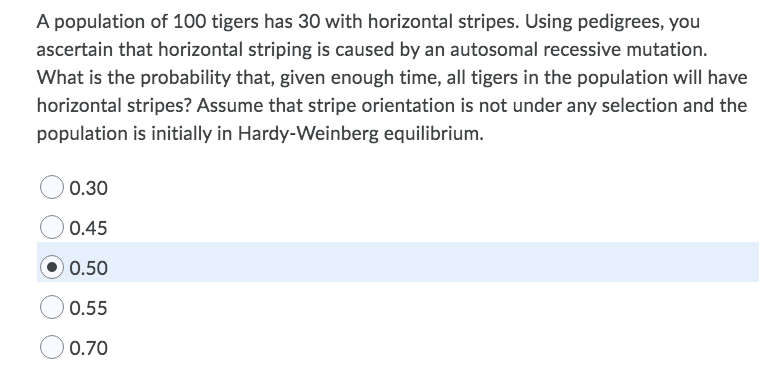Have you ever stared into the mesmerizing eyes of a tiger, its sleek, striped coat seeming to shimmer with an ancient power? The sight is awe-inspiring, a testament to the intricate beauty and efficiency of evolution. But how did these iconic stripes come to be? The answer lies in the slow, gradual process of natural selection, a journey sculpted over millions of years.

Image: www.analyticsinsight.net
To understand the evolution of tiger stripes, we must first grasp the concept of gradualism, a fundamental cornerstone of evolutionary theory. Gradualism posits that evolution occurs through small, incremental changes over vast periods. Unlike sudden, dramatic leaps, gradualism paints a picture of constant adaptation, with each generation inheriting slightly modified traits that contribute to its survival and reproduction.
The Stripes’ Evolutionary Journey: From Shadows to Camouflage
Imagine a distant ancestor of the modern tiger. This ancient feline, unlike its striped descendants, boasted a more uniform, dappled coat. In the dense undergrowth of its environment, this coat offered a slight advantage, providing some degree of concealment from predators or prey.
Now, picture a mutation occurring within this population. A single individual develops a slightly more pronounced pattern of stripes. This subtle variation, a product of random genetic change, may have offered a greater degree of camouflage against the dappled light filtering through the forest canopy. This subtle advantage, however small, would have translated into a heightened chance of survival and reproduction.
The offspring of this “striped” ancestor, inheriting the genes for the more pronounced pattern, would have enjoyed a similar advantage in the dappled light, leading to their own successful reproduction. Over countless generations, this pattern of slightly enhanced camouflage continued to be passed down, gradually refining the stripes and enhancing their effectiveness.
The Power of Natural Selection: Favoring the Striped
This gradual selection process is the heart of natural selection. Nature, in its role of ultimate selector, favors traits that increase the chances of survival and reproduction. In the case of the tiger, the gradual evolution of stripes became a crucial adaptation, enhancing the animal’s ability to hunt and evade predators.
The stripes’ role in camouflage extends beyond simple concealment. Their intricate pattern also acts as a disruptive pattern, breaking up the tiger’s silhouette and making it harder for prey animals to spot them in the dense brush. A prey animal, struggling to discern the distinct shape of a tiger against the dappled background, is less likely to detect the lurking predator, enhancing the tiger’s hunting success.
The Stripes’ Hidden Advantages: More Than Just Camouflage
While camouflage plays a crucial role, the evolution of tiger stripes also reveals a fascinating interplay of natural selection and other factors.
For instance, the stripes’ placement on the tiger’s body isn’t random. The vertical stripes, prominently present on the body and legs, likely contribute to a visual illusion, further breaking up the tiger’s shape and making it appear more like a blur of movement. This “stripey blur” can disorient a potential prey, making it harder for them to react effectively to the attack.
Further, the stripes on the tiger’s face serve a unique purpose. The dark stripes surrounding the eyes help reduce glare, enhancing the tiger’s vision in dense foliage and allowing it to effectively assess its surroundings. These facial stripes may also contribute to communication, with variations in their patterns potentially conveying social signals within tiger groups.

Image: www.chegg.com
Beyond Camouflage: Stripes in the Tiger’s Social Life
Research suggests another intriguing aspect of tiger stripes: their role in social interaction. Each tiger’s stripe pattern, unique like a fingerprint, may serve as a visual identifier, allowing tigers to recognize each other within their social groups. This visual recognition could be crucial for maintaining social structure, avoiding conflict, and facilitating cooperative behavior within tiger populations.
The intricate patterns of tiger stripes, sculpted by millions of years of gradual evolution, not only enhance camouflage and hunting success but also reveal the complex interplay of adaptation, social behavior, and the power of natural selection. These stripes, mesmerizing in their beauty, tell a silent story of resilience, adaptation, and the enduring legacy of evolution.
The Stripes’ Legacy: A Lesson in Adaptation and Resilience
The story of tiger stripes stands as a testament to the incredible power of adaptation. Each generation, inheriting slightly modified traits, shaped the majestic stripes we see today. The stripes, honed by natural selection, represent the ultimate embodiment of “survival of the fittest,” a symbol of relentless adaptation within a constantly evolving world.
Understanding the evolution of these iconic stripes offers a glimpse into the breathtaking complexity of life on Earth. It reminds us that every living creature, from the tiniest insect to the mighty tiger, is a product of a long, delicate journey of adaptation, a journey sculpted by the forces of natural selection over countless generations.
Explain How Tiger Stripes Could Have Evolved Through Gradualism.
Further Exploration: Delving Deeper into the Stripes’ Tale
The journey of tiger stripes is a fascinating one, full of intricate detail and intriguing questions. To explore this captivating story further, consider delving into the scientific literature on evolutionary biology and animal behavior. You can also support conservation efforts for tigers, ensuring that these magnificent creatures and their iconic stripes continue to grace the planet for generations to come.





